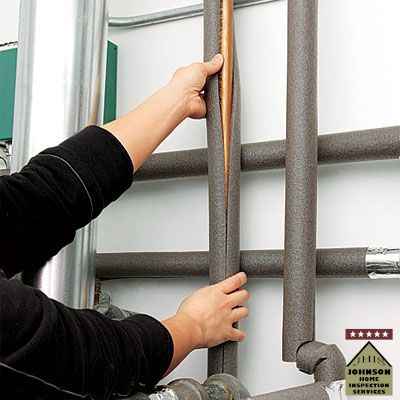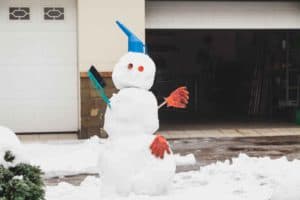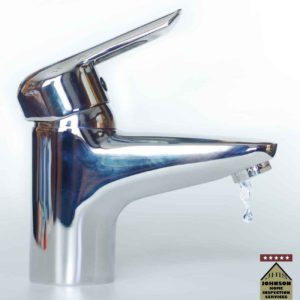
Having water damage in your home can be very detrimental to its overall value. This is mainly because of complications like mold and mildew growth that can often occur after the initial water exposure. One of the biggest culprits to water damage in residential homes is caused by freezing pipes that burst during cold periods of winter. This is especially true here in northern Illinois as temperatures average in the teens during January and February.
Since our nights here in the Rochelle area can often be so cold this time of year, we wanted to share just a few tips on how to keep your pipes from freezing this winter and avoid costly water damage that can significantly reduce the value of your home.
How Can You Keep Pipes from Freezing?
Keeping pipes from freezing during cold winter months can be a major challenge. Some things that have been known to significantly reduce the risk of freezing pipes include heat tape with a UL thermostat included, foam insulation on pipes, insulating crawl spaces under trailers and homes without basements, making certain your pipes are not exposed to drafts from the outside and using a light source for heat generation on your pipes.
As you can see above, there are quite a few different things you can do to keep the pipes from freezing and all of them have their pros and cons.
Tip #1 – Heat Tape
Should You Use Heat Tape to Keep Pipes from Freezing?
 It’s important that you know the risks and benefits of heat tape so you can make an educated decision on if it’s your best option for frozen pipe prevention. Heat tape can be an excellent and relatively inexpensive way to keep pipes from freezing during cold months. The bad news is that heat tape does pose some risks and has been known to catch fire if not properly used. Here are just a few tips that you can use to find quality heat tape and install it properly so that you minimize fire risks.
It’s important that you know the risks and benefits of heat tape so you can make an educated decision on if it’s your best option for frozen pipe prevention. Heat tape can be an excellent and relatively inexpensive way to keep pipes from freezing during cold months. The bad news is that heat tape does pose some risks and has been known to catch fire if not properly used. Here are just a few tips that you can use to find quality heat tape and install it properly so that you minimize fire risks.
- Only Buy UL-Endorsed Tape – Heat tape that has been UL endorsed will include a thermostat built into the tape. This small addition helps to keep the tape from overheating.
- Make Certain to Clear Debris – One of the most common causes for heat tape fires is that the tape becomes too hot and causes surrounding debris like loose insulation or even spiderwebs to catch fire. When you go to install your tape, make certain that everything is tidy around your pipes.
- Follow the Manufacturer’s Instructions – Even if you’re a seasoned veteran of heat tape installation, make certain to read the manufacturer’s instructions before applying it to your pipes. You need to do this because every manufacturer creates their tape to unique specifications. This means that while using foam insulation on one type of tape is recommended, it may be a potential fire risk with another company’s tape.
- Heat Tape Works Best on Small Sections – Unless the manufacturer’s instructions tell you differently, most heat tapes can be applied to the entire length of pipe. However, heat tape often works the best when it’s placed on small sections of high-risk pipes. This is especially true for small sections of pipe that are easy to access but are often more exposed to the elements. Areas to really look out for our where pipes run along exterior walls, especially in the corners.
Just to sum it up, heat tape can be a great temporary solution that can help reduce your risks of freezing pipes for the short term but it’s important to follow the manufacturer’s instructions to the letter, make sure your pipes and surrounding areas are clear of all debris, buy UL endorsed tape and try to keep installation to smaller high risk areas rather than applying the tape to all of your pipes.
Tip #2 – Insulate Like Crazy
 You most likely already know how important proper insulation is when it comes to keeping your heating costs in check but do you know if your pipes are properly insulated to keep from freezing?
You most likely already know how important proper insulation is when it comes to keeping your heating costs in check but do you know if your pipes are properly insulated to keep from freezing?
Unless you personally insulated your home, the most common answer to this question is no. Don’t be too hard on yourself though. The thing with insulation around pipes is that most of us don’t even think about it until the damage is already done.
Should You Insulate Your Pipes to Keep Them from Freezing?
If you’re concerned with your pipes freezing this winter, it’s important that you take a quick look in the more common areas were insulation around pipes can be lacking to determine if you should add additional insulation.
There’s absolutely nothing wrong with insulating all your pipes but if you’re concerned with freezing soon, there are a few hotspots you should check out:
- Basements and Crawl Spaces – There are numerous different areas in your home where pipe insulation may be lacking, the most common ones that freeze are often located in areas that you don’t frequent like above basement drop ceiling tiles or inside the crawlspaces of homes that don’t have a finished basement. Often, pipes are installed beneath your floors and it’s simply a case of out of sight, out of mind. When it comes to keeping your pipes from freezing
however , the first places you are going to want to check are those that you don’t often see.
- Attics – While it’s rare in modern homes, pipes were occasionally installed in the attics of older homes. If you’re a newer
home owner , make sure to check and see if there are any exposed pipes in your attic. When it comes to water damage, a busted pipe in the attic can wreak havoc on the walls below and often go undetected for a very long time.
- Outdoor Spigots and Faucets – One of the most exposed and often forgotten areas of pipe that can freeze the easiest are outdoor spigots and faucets. Often the best course of action for spigots during the winter is to simply shut off the water to the spigot and bleed the line prior to the arrival of winter. At the very least, insulate the pipes leading to the spigot and consider applying heat tape on the pipe inside of your home.
Tip #3 – Avoid the Garage
 Another area where frozen pipes are more common for many people
Another area where frozen pipes are more common for many people
Tip #4 – Expose Your Interior Pipes to More Warm Air
This is perhaps the fastest and easiest tip on the list. By simply opening the cabinets beneath the sinks in your kitchen and
Tip#5 – Drips Are A Good Thing

Flowing water requires much lower temperatures to freeze and even a drip will often keep the water in your home’s pipes from freezing solid. So, before you head to bed take a minute to go to each sink and
Tip #6 – Don’t Touch the Thermostat
Turning down your thermostat at night can help you save a little bit on your heating bill, but when you’re concerned about your pipes, the thermostat should be avoided at all costs!
That slight chill inside of your home could be a huge temperature change where pipes are most exposed. While next months electric bill may save a few dollars, repairing your home after the havoc a busted pipe can cause will be a huge investment of your time and money.
Tip #7 – Inspect Your Home for Drafts and Cracks
Small cracks can cause your pipes to become exposed to drafts of cold air while the rest of your home is nice and cozy. Look around the areas where your pipes are at highest risk to make sure you can’t feel any outdoor air rushing past.
If you’re unsure how to check for drafts and cracks, or where your highest risk areas are in your home, give us a call and we can happily arrange for an inspection to help you be certain that the areas around your pipes are draft free.
Final Thoughts
As you can see above, there are a lot of different things you can do to help prevent your pipes from freezing this winter. It all starts with knowing what areas of your home have the greatest risk of frozen pipes.
If you’re unsure about what you should do to keep your pipes from freezing this winter, or you just want to find out what areas of your home have the greatest risk, please give us a call today so that we can schedule an inspection to help you personally determine the biggest risk areas in your home. Just give us a call and we can get started on making sure your pipes stay flowing this winter.
Meta Title – Keep Your Pipes from Freezing With These 7 Tips
Meta Description – One nightmare that many homeowners share is frozen pipes. These 7 tips can help you learn how to keep your pipes from freezing this winter.
URL slug: how-to-keep-your-pipes-from-freezing

To Contact Johnson Home Inspection Services, LLC
Phone: 815-441-1275
Email: Kris@JhisInpections.com
Request a Quote